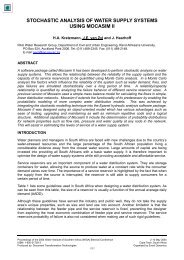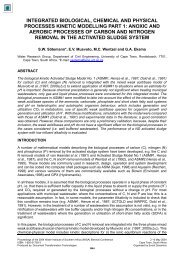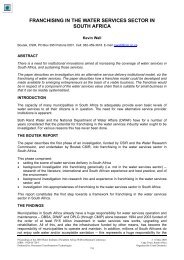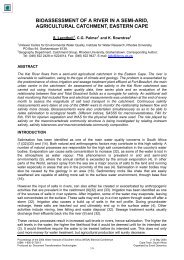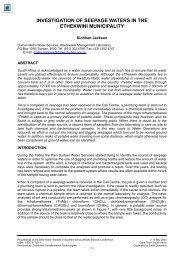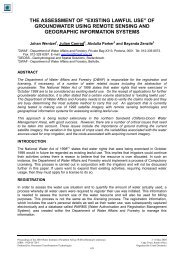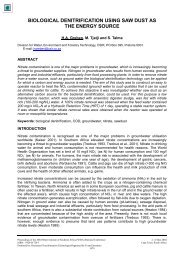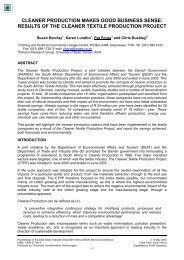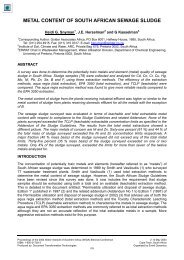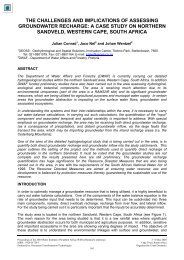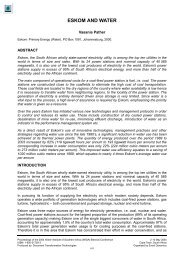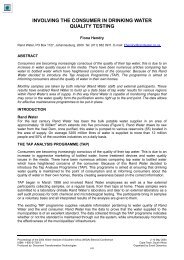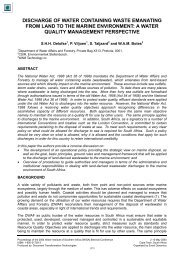Pillay, R.K. - eWISA
Pillay, R.K. - eWISA
Pillay, R.K. - eWISA
You also want an ePaper? Increase the reach of your titles
YUMPU automatically turns print PDFs into web optimized ePapers that Google loves.
A PROCEDURE FOR A RISK BASED HEALTH IMPACT<br />
ASSESSMENT AS PART OF AN ENVIRONMENTAL<br />
IMPACT ASSESSMENT<br />
R.K. <strong>Pillay</strong><br />
Water Quality Management, Department of Water Affairs and Forestry, PO Box 1018, Durban, 4000.<br />
Tel: (031) 3362742. Fax: (031) 3059915. Cell: 082 908 3748. E-mail: pillayr@dwaf.gov.za<br />
ABSTRACT<br />
An Environmental Impact Assessment (EIA) is often an expensive yet effective decision-making<br />
tool increasingly used by a proponent to establish the extent of an Impact of a proposed project on<br />
the Environment. In many countries, including South Africa, it is a legal requirement.<br />
Health and development are intimately related and a consequence of insufficient development may<br />
be poverty resulting in potential health related problems. Since water and sanitation are vital in any<br />
community, developments that have an impact on the quality of water need to be evaluated not<br />
only from an environmental perspective but a health perspective as well.<br />
A Risk-Based Health Impact Assessment is a process of identifying, predicting, evaluating and<br />
mitigating the health effects of developmental proposals prior to major decisions being taken and<br />
commitments made.<br />
This paper is an attempt to provide a means of determining the health risks arising out of a project.<br />
A thorough procedure to identify and mitigate these risks will enable the relevant authorities to<br />
make decisions based on sound data.<br />
The use of a risk-based Health Impact Assessment in development planning is still in its infancy in<br />
South Africa and most other developing countries. This paper also aims to provide a generic<br />
method, which if used consistently by practitioners, will enable decision makers to easily compare<br />
results and experiences from various projects.<br />
This ultimately leads to a properly integrated Environmental Impact Assessment that will be of<br />
benefit to both the developer and stakeholders involved.<br />
INTRODUCTION<br />
Human health, the environment and development are intricately linked in that a negative impact in<br />
any one sphere would impact negatively on the remaining two spheres. For example, insufficient<br />
development of proper sanitation facilities would lead to unhygienic and unhealthy living conditions<br />
for humans as well as impact on the environment by causing pollution to water resources.<br />
Sustainable development requires that ‘development meets the needs of the present generation<br />
without compromising the future generations to meet their own needs’ and that the environmental,<br />
social and economical implications of any development project are considered in order to achieve<br />
development that is sustainable.<br />
Globally, there is great concern regarding environmental, social and health impacts of development<br />
projects. Agenda 21, adopted by many countries at the Rio de Janeiro Earth Summit in 1992,<br />
emphasised the need for Environmental Impact Assessments to help predict impacts of<br />
development on the environment (9). The EIA is defined by the International Association for Impact<br />
Assessment as the process of identifying, predicting, evaluating and mitigating the biophysical,<br />
social and other relevant effects of development proposals prior to major decisions being taken<br />
Proceedings of the 2004 Water Institute of Southern Africa (WISA) Biennial Conference 2 –6 May 2004<br />
ISBN: 1-920-01728-3 Cape Town, South Africa<br />
Produced by: Document Transformation Technologies Organised by Event Dynamics
and commitments made. EIA is internationally recognised as the primary decision-making tool for<br />
examining the ecological, social, economic, cultural and related health impacts of proposed<br />
development and human activities.<br />
While health is raised as an issue in the EIA, it is often not given in-depth attention and the focus is<br />
mainly on the negative implications of the development on health and does not evaluate or<br />
drawn-on the positive aspects. Internationally there has been a shift towards recognising that shift<br />
towards recognising that the assessment of development on human health also known as HIA is<br />
an important component of EIA (7). It is becoming more imperative that a procedure for HIA and in<br />
particular Risk Based HIA be formulated for South Africa<br />
WHAT IS A HEALTH IMPACT ASSESSMENT (HIA)?<br />
Health Impact Assessment is a combination of procedures, methods and tools by which policy,<br />
programmes or development projects can be judged as to its potential effects on the health of a<br />
population and the distribution of these effects with the population (8).<br />
The purpose of HIA is two-fold in that it can be used to assess the potential positive and negative<br />
health impacts of proposed policies, programmes and in particular developments and plays a role<br />
as a supporting decision-making tool by making recommendations on how to maximise the positive<br />
health impacts and minimise the negative health impacts. In doing so, the process alines itself with<br />
the principle of sustainable development.<br />
WHY HIA?<br />
Traditional EIA doesn’t often identify the positive effects of health that development may have (7).<br />
The reporting of human health effects is not seen to be influenced by many factors (i.e analysis is<br />
too narrowed) and seems to be confined to only the negative health impacts. The cost of failing to<br />
protect and promote health falls on government and the community in general.<br />
Since HIA offers a framework for identifying health impacts and means of addressing the problems,<br />
it can be used as an aid in the EIA process. HIA should not be seen as the sole decision making<br />
tool but should rather be used as a support tool in the decision making process (6). HIA can be<br />
easily utilised in any situation where a development project or policy has health implications.<br />
HIA allows for a framework in which significant adverse health impacts can be mitigated and<br />
positive impacts are enhanced. It can prevent the need of costly late changes to development (7).<br />
It can also demonstrate the potential health gain of a given proposal.<br />
It draws on a range of different technical skills and is therefore not limited to any one particular<br />
scientific field i.e. health authorities are not the only people consulted in this particular field of work.
A multidisciplinary task team is required. HIA therefore draws on the experience of a wide range of<br />
stakeholders ranging from community representatives to technical experts to various tiers of<br />
government. It therefore increases transparency and builds capacity.<br />
HIA does not limit factors that influence human health and well-being. It acknowledges the<br />
cross-sectoral nature of health (7). It is determined by a wide range of factors that can include<br />
economical, social, environmental factors as well as access to health services, family lifestyles,<br />
drug/alcohol abuse, vulnerable and disadvantaged groups.<br />
HIA not only evaluates how a development will affect human health but also looks at whether there<br />
may be a disproportionate effect on a particular population or area. It also considers the potential<br />
or actual impacts on health and the inequalities and interaction between these impacts (6).<br />
HIA also involves the incorporation and evaluation of quantitative scientific evidence where it exists<br />
(e.g. existing health status data) as well as qualitative information (e.g. community opinions).<br />
It contributes to sustainable development and aligns itself with the South African Constitution (Act<br />
108 of 1996). It provides a platform for Interested and Affected Parties to voice their concerns<br />
regarding health and proposed development.<br />
It strength lies in acting as a support tool to the decision-making process regarding development<br />
and by identification and assessment of potential health impacts and in allowing for ways of<br />
addressing such impacts.<br />
WHY RISK BASED HEALTH IMPACT ASSESSMENT (RBHIA)?<br />
The main aim of RBHIA is to estimate levels (current and future) of risk and hazard associated with<br />
the particular development to human health. It is important to note that the mere presence of<br />
potential threatening factors does not necessarily constitute a risk. In order for a risk to exist, the<br />
following three conditions must be met:<br />
• Potential health hazards must exist<br />
• Health hazards must be deemed to have an effect; and<br />
• Pathways by which human are exposed to this impact exist<br />
Figure 1 represents the interaction of these three components that could result in the presence of a<br />
risk.<br />
Figure 1. The 3 basic components of risk.<br />
An RBHIA is a powerful tool in that it promotes the precautionary principle and assesses what<br />
health risks are linked to each of the health hazards as identified by the various stakeholders,
existing and current evidence. It is an effective way of establishing whether each of the health<br />
determinants would increase, remain constant or decrease the potential health risk (9).<br />
LEVELS OF HIA<br />
The HIA can be undertaken at different degrees of intensity ranging from desktop/rapid level HIA to<br />
a full scale comprehensive HIA.<br />
METHODS FOR CONDUCTING RBHIA<br />
Profiling of Affected Area/Community<br />
Profiling is a vital part of RBHIA in that it provides decision makers with an idea of the current<br />
health status of both the affected environment and community. It provides the baseline from which<br />
possible health impacts can be assessed. Profiling includes the assessment of the nature and<br />
characteristics of the population whose health may be placed at risk by the development.<br />
The following information can be collected as part of the Profiling process (5):<br />
• Characteristics of populations – These include:<br />
- Size<br />
- Density<br />
- Age<br />
- Sex<br />
- Birth rate<br />
- Mortality rate<br />
- Distribution<br />
- Economic status<br />
- Vulnerable groups<br />
- Disadvantaged groups<br />
• Health status of population and the vulnerable/disadvantaged groups<br />
• Employment/unemployment statistics<br />
• Health behaviour indicators (e.g. drug or alcohol abuse)<br />
• Environmental conditions<br />
• Location of the ‘at risk’ groups
Stakeholder Identification<br />
Stakeholders are vitally important throughout the entire RBHIA process. The experience and<br />
expertise of a wide range of stakeholders and key decision makers are necessary as it aids in<br />
identifying potential concerns and hazards surrounding human health. Public participation ensures<br />
that community concerns are noted and addressed.<br />
Stakeholders include some of the following:<br />
• Community representatives<br />
• Proponent of development project<br />
• Specialists<br />
• NGO’s<br />
• Representatives from various authorities ranging from local to national government<br />
Identification of Health Hazards<br />
Identification of health hazards involves qualitative research with stakeholders and key decision<br />
makers. It involves identifying all potential health hazards associated with the development. This is<br />
initially conducted as part of a desk stop study in the screening phase.<br />
Assessing Health Hazards as Health Risks (RBHIA)<br />
The RBHIA assesses the health risk associated with each of the identified health hazards on the<br />
basis of looking at health determinants. The person/s assessing the health risks should judge<br />
whether each of the health determinants would either increase or decrease the potential health<br />
hazards and their risk to human health. For convenience health hazard or health determinants can<br />
be categorised as follows (This Matrix can be modified according to the project needs).<br />
The Matrix should reflect whether there is an increase, no change or a decrease in the risk. This is<br />
put into the format of a Health Impact Statement.<br />
Risk assessment can use health-based guidelines or objects and can also include quantitative and<br />
qualitative evidence.<br />
Health Risk Management<br />
Health Risk Management is the process of evaluating alternative actions, selecting options and<br />
implementing them in response to the risk assessment (7). Once health risks have been assessed,<br />
recommendations can be put forth to maximise positive impacts, minimise negative impacts or<br />
modify the development proposal<br />
PROCEDURES FOR RBHIA<br />
There are basically six stages in a Risk Based Health Impact Assessment. Figure 2 is an<br />
illustration of these stages and their relation to one another. The figure also illustrates the different<br />
levels of intensity of an RBHIA.<br />
Screening (Stage 1)<br />
Any proposed development that undergoes an EIA process should in turn be screened for potential<br />
health impacts as well. The first stage of the RBHIA process is to evaluate if a given development<br />
project requires a RBHIA. This is usually determined by conducting a rapid level RBHIA. The<br />
screening process would thus divide development into two classes:<br />
Class A: Serious health impacts. Require a full scale or intermediate RBHIA.<br />
Class B: No serious health impacts (i.e. health impacts are negligible or are well known and<br />
properly controlled). No further action is required. No need for full scale RBHIA.
Figure 2. The stages of an RBHIA.<br />
The results of a desktop/rapid level RBHIA would need to be tabulated as a simple Matrix. Table 1<br />
is an example of results achieved by conducting a desktop level RBHIA for the construction of<br />
oxidation ponds to service an informal settlement.<br />
Scoping (Stage 2)<br />
If the screening phase determines that the development proposal falls into Class A, then the<br />
scoping stage is necessary. Scoping is the process of identifying the potential issues that will need<br />
to be addressed in the RBHIA. Scoping defines the timing and extent of the RBHIA as well as<br />
sources of relevant expertise required (9). It is also an important step in linking the need for RBHIA<br />
and the assessment of risks and the monitoring and management that follows. The scoping phase<br />
of the RBHIA should ideally co-incide with that of the EIA.<br />
It is usually at this stage that a Steering Committee or Advisory Forum is established. This<br />
committee/forum should comprise a wide range of stakeholders, which should include community<br />
members, representatives from the different tiers of government, NGO’s, technical experts and<br />
other Interested and Affected Parties who are responsible for establishing the Terms of Reference<br />
(TOR) for the development proposal.
Table 1. Example of a RBHIA Matrix.<br />
Project Stage Health Hazard Reasons Change in Mitigation<br />
Health Risk Measures<br />
Stage 1<br />
Agents causing The creation of an aquatic habitat for Small increase Improve health<br />
(Construction) vector borne vectors and exposure to vectors in<br />
service to area<br />
diseases<br />
endemic disease foci<br />
Agents causing Increase in immigrants due to<br />
Small increase Education and<br />
STD’s<br />
improved service standards and<br />
provision of<br />
increase in outside labourers.<br />
condoms<br />
Agents causing Use of large machinery and<br />
Large risk Improve<br />
injury<br />
inadequate occupational safety<br />
security and<br />
measures. Theft of safety equipment<br />
educate<br />
labourers on<br />
occupational<br />
safety issues<br />
Stage 2<br />
Agents causing The creation of an aquatic habitat for Medium – Large Improve health<br />
(Implementation) vector borne vectors and exposure to vectors in increase<br />
service to area<br />
diseases<br />
endemic disease foci<br />
Agents causing Large influx of immigrants and higher Medium<br />
No mitigation –<br />
criminal behaviour level of unemployment due to lay offs increase<br />
out of scope of<br />
after construction phase<br />
project<br />
Agents causing Use of large machinery and<br />
Decrease in risk No mitigation –<br />
injury<br />
inadequate occupational safety due to removal positive impact<br />
measures. Theft of safety equipment of construction<br />
machinery<br />
Stage 3<br />
Conditions causing Increase in immigrants and<br />
Small – medium No mitigation -<br />
psycho-social unemployment. Increase in shebeens. increase<br />
out of scope of<br />
disorders<br />
project<br />
Agents causing Consumption of fish and water from Large increase Education of<br />
communicable oxidation pond. Use of overflow from<br />
community and<br />
diseases<br />
ponds to wash clothes, etc.<br />
fencing of<br />
ponds and<br />
signage in<br />
local<br />
languages<br />
Agents causing Possible use of chemicals for<br />
No increase Chemicals not<br />
poisoning<br />
treatment<br />
used for<br />
oxidation<br />
ponds<br />
The summary of the intermediate or full scale RBHIA would need to be condensed and presented<br />
in the form of a Matrix that can be attached as part of an EIA and is easy to comprehend.
Assessment/Appraisal (Stage 3)<br />
This stage is considered the most important stage of the RBHIA. It involves investigating,<br />
appraising/evaluating and reporting on how the proposed development is likely to affect the health<br />
of the population.<br />
This usually involves the following methods:<br />
• Examining the project<br />
• Collecting and collating the best available qualitative and quantitative evidence (6)<br />
• Considering evidence and assessing the impact<br />
• Reporting on the impact<br />
Recommendations [Health Impact Statement] (Stage 4)<br />
Once the potential health impacts have been assessed and rated in terms of significance,<br />
recommendations can be made to either modify the project, consider alternatives, possible<br />
mitigation measures or other conditions in order to minimise the negative health impact and to<br />
maximise the positive impacts. This usually results in the formulation of a Health Impact Statement<br />
or Report.<br />
Further Engagement with Decision Makers (Stage 5)<br />
In order for the recommendations to be adopted or incorporated into the EIA, further discussions<br />
must be held with all decision-making authorities. RBHIA must be viewed as a support tool to aid in<br />
the decision-making process. Judgement calls still have to made and in some EIA’s there may be<br />
another parameters that are considered more important than health. It must be remembered that<br />
the decision-making capacity doesn’t lie with the health authority only.<br />
On-Going Monitoring and Evaluation (Stage 6)<br />
This is the last but equally important stage that is often forgotten in other types of Assessments. A<br />
good RBHIA will aim to monitor and evaluate whether any of the recommendations and conditions<br />
attached have been applied or omitted to the development. This stage will also assess whether the<br />
positive impacts on human health were enhanced and if the negative aspects were indeed<br />
minimised. It is also assess the accuracy of prediction made during the appraisal/assessment<br />
stage (6). This will aid authorities in improving the RBHIA process and determine if the process<br />
was indeed a valuable one by noting if there is an improvement in the health status of the<br />
community over time.<br />
CONCLUSION<br />
The use of an HIA as part of an EIA is not widespread in South Africa as this is usually addressed<br />
on an adhoc basis. RBHIA can be utilised to focus the assessment of risks associated with projects<br />
that range from drinking water quality, waste management to water resource development (dams,<br />
irrigation schemes) (3). It is important that an RBHIA take into account the endemic characteristics<br />
of the country in which it is applied. The RBHIA should also be in line with the legislative<br />
requirements of that specific country. Equity, economics and sustainability should be the guiding<br />
principles in any RBHIA.<br />
REFERENCES<br />
1. L. B. Lerer,”Health Policy and Planning”, pub Oxford University Press, 14(2) p. 198-203 (1999).<br />
2. M. H. Birley, “Guidelines for Forecasting the Vector-Borne Disease Implications of Water Resources<br />
Development”, PEEM Guideline series #2 (ed. 2), (1991).<br />
3. Report of An Inter-Regional meeting on harmonisation and mainstreaming of RBHIA in the World<br />
Health Organisation and of a Partnership meeting on the institutionalisation of RBHIA capacity<br />
building in Africa, Geneva, (2001).<br />
4. G. Pritchard, “South Essex Health Authority-Health Impact Assessment Tool”, pub South Essex<br />
Health Authority, UK, (1999).<br />
5. A. Birley et al, “The Merseyside Guidelines for Health Impact Assessment”, pub International Health<br />
Impact Assessment Consortium, UK (ed. 2), (2001).
6. NHS Health Development Agency, “Introducing Health Impact Assessment: Informing the<br />
decision-making process”, pub Health Development Agency, UK, (2002).<br />
7. Health Impact Assessment Guidelines, pub Commonwealth of Australia (Department of Health and<br />
Aged Care), (2001).<br />
8. European Centre for Health Policy, “Health Impact Assessment: Main concepts and suggested<br />
approach”, The Gothenburg Consensus Paper, (1999).<br />
9. P. Furu, “Health Impact Assessment: A multi-disciplinary approach in development planning”, DHI<br />
Water and Environment, Public Health Programme, (2001).



